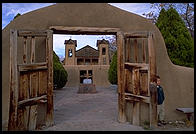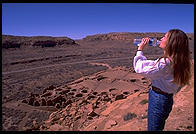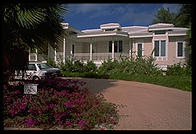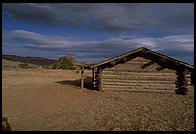
Nikon 24/2.8 AF lens
by Philip Greenspun; created 1995
Site Home : Photography : Nikon 24/2.8 AF lens

by Philip Greenspun; created 1995
Site Home : Photography : Nikon 24/2.8 AF lens
 I did
a "save as" on my
20/2.8 review so if you've already read
that, you're going to be experiencing deja vu all over again...
I did
a "save as" on my
20/2.8 review so if you've already read
that, you're going to be experiencing deja vu all over again...
There isn't a whole lot to say about a fixed 24 lens. Nikon's is sharp and contrasty. All of Nikon's "very wide" lenses have "close-range correction" (CRC). This is a "floating element" that moves relative to the other pieces of glass inside the lens as you focus. Most lenses just move a whole rack of optics in and out as you focus. They are optimized for subjects 3 meters away but perform adequately at infinity or close-up. I don't understand optics, but I know that this doesn't work for extreme wide angles. You lose a lot of optical quality close up if you don't change the configuration. This is very important because most of the interesting pictures that one can take with a 24 are "near-far" images, with a relatively close main subject and an interesting background far away.
These are from my New Mexico Exhibit:
 Photojournalism has been getting wider and
wider over the years; 24 is not even "very wide" anymore. Wide angle lenses are
good for showing a group of people, one or two people close up, and the
background. Of course,
the
perspective is not always the most flattering.
Photojournalism has been getting wider and
wider over the years; 24 is not even "very wide" anymore. Wide angle lenses are
good for showing a group of people, one or two people close up, and the
background. Of course,
the
perspective is not always the most flattering.
A 24 is beginning to be adequate for taking pix of people in tight spaces. At left, I managed to get a snapshot of the driver in a 3-man submarine in the Cayman Islands. More of the time, I find myself needing 20 or even a 14 or 15mm rectilinear wide angle.

 If you forgot your perspective correction
lens, you can sometimes get an adequate undistorted image of a tall building by
backing up, holding the camera level, and cropping after you get home (see Ghost
Ranch photo below). This works better with a 20 held, though. The 24 is OK for
ranch-style houses like my friend Bob's here on
Grand
Cayman.
If you forgot your perspective correction
lens, you can sometimes get an adequate undistorted image of a tall building by
backing up, holding the camera level, and cropping after you get home (see Ghost
Ranch photo below). This works better with a 20 held, though. The 24 is OK for
ranch-style houses like my friend Bob's here on
Grand
Cayman.
I stole my 24/2.8 from a friend of mine. I think it is normally about half the price of the 20/2.8, i.e., about $250. Off-brand lenses are much much cheaper than manufacturer wide angles. That's because they don't have a floating element (see above) and hence are incapable of quality results when focussed close.
I've become very fond of my Canon EOS 20-35/2.8 zoom. Not because of the optical quality, which is obviously less than the Nikon fixed 24/2.8, but because of the flexibility. Nikon's 20-35/2.8 zoom is allegedly marvelous. That's what I would buy today instead of a fixed 24 if I had 8X the money to spend. However, don't be tempted to substitute an off-brand 20-35 zoom for the Nikon 24. You won't get comparable results.
I would not buy the Nikon 28 AF lens. For starters, 28 isn't really dramatically wide anymore for viewers who've seen modern movies and still images. Secondly, did you ever notice how cheap the original Nikon 28 AF was compared to their old MF 28 lenses? That's because Nikon decided that their AF customers were unwashed slobs who wouldn't be able to tell the difference if they left out the floating element (CRC). The latest D version of the 28AF allegedly has the CRC element and they've upped the price a bit.
Text and pictures copyright 1991-1995 Philip Greenspun